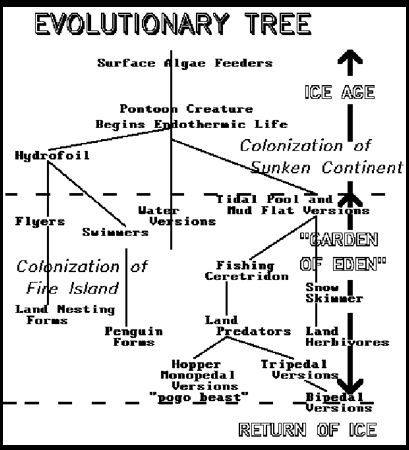The Shape of Things to Come
Poncedonus and Ceretridon
As volcanic activity awakens Epona from its 100 million year freeze, rapid environmental changes occur. Displacement of sea water by the new volcanic constructs of the growing Highlands and the melting of the grounded ice caps raises sea level. Most of the Sunken Continent sinks to resemble the scattered group of micro‑continents and islands on the map. Many of the near‑shore habitats we have described are drowned. There is strong evolutionary pressure for biological change once more. But there are new niches to be colonized also: carbon dioxide is building up in the atmosphere again, plants can start to acquire it from air as well as sea‑water; the ice is also beginning to leave the land and multi‑cellular life takes steps to replace it. It was in this period of evolutionary flux in the region of the Sunken Continent that the Poncedonus became the Ceretridon, the generic ancestor to a major part of the land fauna and the possible forerunner of our sophont.
 The Evolutionary Tree figure shows the evolutionary family tree of the Poncedonus and Ceretridon (invented by Geoffrey Landis). We see that even before the end of the ice age the Poncedonus had evolved an ocean‑going "Hydrofoil" species, large, streamlined and with an powerful hind leg, it was one of the fastest swimmers on the planet. This was one of the first creatures to evolve onto the land of the Highlands and later Fire Island, but we know nothing more of its descendants.
The Evolutionary Tree figure shows the evolutionary family tree of the Poncedonus and Ceretridon (invented by Geoffrey Landis). We see that even before the end of the ice age the Poncedonus had evolved an ocean‑going "Hydrofoil" species, large, streamlined and with an powerful hind leg, it was one of the fastest swimmers on the planet. This was one of the first creatures to evolve onto the land of the Highlands and later Fire Island, but we know nothing more of its descendants. 
Bubble weed was one of the first macroscopic plants to come ashore and make a permanent home for itself. When there was still much ice about, it would blow in the wind (like clumps of tumbleweed) onto areas of thawed ground, where rootlets would collect nutrients from the soil. A descendant of the Poncedonus, the "Snow Skimmer" followed the bubble weed onto land, becoming the first large colonist -- an herbivore with its pontoons modified into skis, its hind leg pushing it across snow or ice in search of food. As the ice disappeared completely skis became feet and further evolution produced a variety of land herbivores.

Meanwhile, on shore, the first Ceretridon appeared (see right). It had moved on a long way from the original Poncedonus and was the first descendant to walk. Pontoon limbs (limbs 3&4) had evolved into legs with padded feet, as did the hind limb (limb 5). Thus it walked on three legs, the two original forelimbs (limbs 1&2) becoming further reduced into mouthparts. It retained its four eyes, although still relies mainly on two; what the other pair are for, since it is now too big to be preyed upon by avians, has yet to be decided. From the Ceretridon evolved a variety of land predators and omnivores which divided into three basic body plans:
1) Tripedal versions, like the original;
2) Monopedal "Hopper" versions; and
3) Bipedal versions.
Monopods (see left) achieved locomotion by hopping kangaroo‑fashion on a strengthened hind leg, the forelimbs being held off the ground (hence its nickname "pogo beast"). When resting however, or rooting through low undergrowth, the monopod would rest on its forelimbs (limbs 3&4), the "hands" of which have rudimentary prehensile ability. Bipeds instead used the paired forelimbs
(3&4) for locomotion (hence its nickname "knuckle walker") and held its hindlimb tucked under the body (see below). The hind limb was normally brought into play as a prop when standing or as a weapon. For the latter use, it was particularly effective, the foot becoming modified into a lethal "claw" that could be thrust into an opponent's underbelly. This weaponry and the ability of the biped to run at a fast, sustained rate made the bipeds into a family of predators.
Speaking of predators, the Springcroc had also evolved a land based descendant. The lower illustration in the figure below shows this later version, little of which is currently known. (Martyn likes to think of it as being amphibious and leaping up out of pools or rivers to attack unwary herbivores which had paused for a drink.) It clearly is not designed for prolonged running on land and even in Coti Mundi's lower gravity as its hopping locomotion is plainly suited to short, powerful, bursts of speed. As we might expect, the shape of the Springcroc has evolved quite significantly. The 'shell' section seems to have shrunk and elongated and the 'stomach' now seems to be permanently extruded into a fleshy 'head'. If this is a correct interpretation, could the member of the original design team tell us more? How does it catch food now? Since it has no jaws, how does it tackle eating? Does it still engulf prey, poison them or what? What are the nature of the anterior sense organs, two of which seem to have evolved into primitive manipulanda?
Ready to find out more?
Act II closes



